The Campaign for Drawing in collaboration with the Guild of St. George is delighted to bring an exhibition of drawings, paintings, prints and textiles by 23 artists shortlisted for the second John Ruskin Prize to Trinity Buoy Wharf. Still a relatively new award, the 2014 theme invited artists over 18 across the UK to submit ‘fresh, contemporary visions of the UK's urban, rural or social environment'. The selection panel considered 600 entries before agreeing on the final 23, which offer an engaging mix of materials, techniques and topical commentary, exploring urban sprawl, dereliction and the endangered British countryside.
The exhibition includes edgy pastoral scenes, candid depictions of 21st century suburbia and two huge drawings by Maggie Hargreaves (the 2014 John Ruskin prize-winner), which reveal nature’s revenge on our despoliation of the countryside.
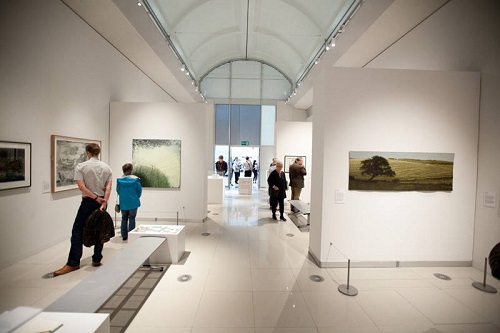
Installation view: Recording Britain Now, Millenium Gallery, Sheffield.
The exhibition offers an engaging mix of materials, techniques and topical commentary, exploring urban sprawl, dereliction and the endangered British countryside. Philip Sanderson's epic tapestry depicting a seemingly idyllic rural landscape contrasts sharply with Mandy Payne's gritty vistas of Sheffield’s once notorious Park Hill estate, created by spray painting directly onto cast concrete slabs.

Mandy Payne, 'Park Hil: Past Imperfect', Spraypaint on concrete. (2014).
Ahead of the exhibition, The Campaign for Drawing’s Rachel Price catches up with Mandy Payne to get under the skin of these powerful works:
RP: Hi Mandy, many thanks for your time, lets launch right in:
The Sheffield exhibition of Recording Britain Now just closed at Millennium Gallery ready to migrate south for the winter to London (Trinity Buoy Wharf) which opens Wed 12 Nov. Do you think interpretations of the theme ‘Recording Britain Now’ differed at all for artists (and indeed visitors) living and working in the North to those living in the South?
MP: The selected artists seemed to come from all over the UK (although there did seem to be a preponderance of artists from Sheffield! (four) so hopefully the Millennium Gallery audience appreciated that! I think a lot of the artists interpreted the theme of ‘Recording Britain Now’ in a similar way, many of the places/ subjects depicted could be considered to be quite generic and so I feel could be appreciated by audiences no matter what their geographical location.
RP: How do you feel your works sat alongside the other pieces in the exhibition?
MP: I really enjoyed the exhibition and was thrilled to have work accepted – I thought all the pieces exhibited worked really well together. There seemed to be a strong homogeneous theme of liminal landscapes, with an emphasis on the overlooked and hidden, with many of the artists finding beauty in places not typically thought to be aesthetic- so I felt my work fitted in well with this theme. I loved the wide variety of medium selected, from paint, print, textiles and relief all having drawing as their root of inception.
RP: The works you entered into the exhibition are part of a series made using aerosol on slabs of concrete which are the result of your research and observation of Park Hill in Sheffield, the Grade II* listed council estate and one of Britain’s largest examples of Brutalist architecture. Sculptural in form and utilising the tools of graffiti, they are almost worlds within a world. What is the process / thinking behind these works?
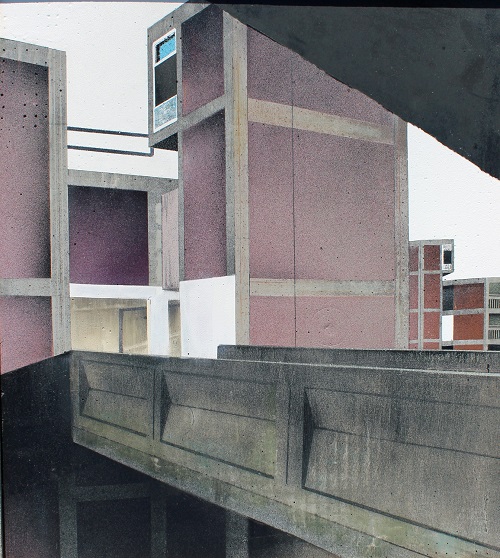
Mandy Payne, 'Bleak' ,aerosol spray paint on concrete (2014).
MP: The work began as part of my final degree show for my part time BFA (I graduated as a mature student from the University of Nottingham last year). Park Hill is currently undergoing regeneration and is thus an interesting place to observe. Part of the estate has been converted into shiny luxury flats, whilst half remains boarded up and derelict. A small remaining part is still inhabited – the residents remaining resolutely in situ until finally decanted. I was particularly drawn to the un-refurbished areas of the estate where the memories and layers of the past are almost tangible. I wanted to create observational paintings that spoke of the desolation and displacement of the established communities and the temporality of the urban landscape. I was keen to work with materials that were integral to the estate itself, namely concrete and aerosol spray paints. I cast the concrete myself into slabs and then spray painted the images directly onto the concrete surface using masking tapes.
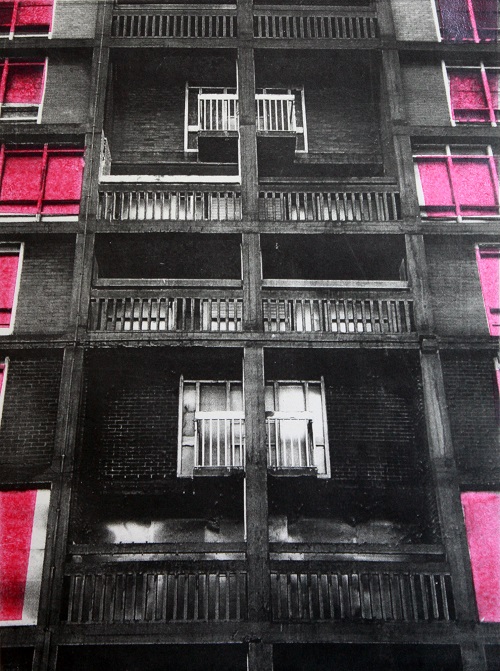
Mandy Payne, 'Broken Brutalism', photolithograph and monoprint, (2014).
RP: You seem to have struck a balance between content and physicality with these particular works. With this in mind, what would you say that there is a particular guiding force in your practice?
MP: My work is quite process driven, I enjoy the physicality of working with different materials and enjoy experimenting to achieve different marks, textures and patinas. As well as painting I also print and find that the two processes often overlap and that my painting feeds into my printmaking and vice versa.
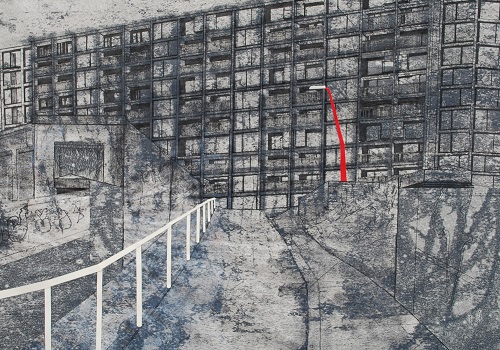
Mandy Payne, 'Liminal Zone', Trace Monoprint and collage, (2014).
RP: You are also a prizewinner for this year’s John Moores painting prize, congratulations! Do you notice any trends or unifying concerns amongst painters at the moment?
MP: I feel there is an awful lot of luck involved in getting work selected for Open Competitions, for example who the judges are and what seems to be ‘current’. I think in both this years John Moores and the John Ruskin Prize there is a strong thread of realism with many of the pieces in both exhibitions also having a strong sense of place and nostalgia but many also possessing an underlying sense of unease or eeriness.
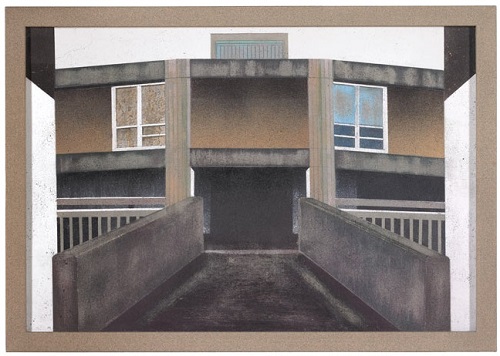
Mandy Payne, 'Brutal' ,aerosol on concrete (2013).
RP: As a representative of The Campaign for Drawing speaking to a shortlisted artist for The John Ruskin Prize we must ask the obvious question: What role drawing plays in your life and practice?
MP: Drawing is absolutely integral to my practice whether I paint or print. I always start off with quite a detailed drawing as a guide to where I need to go next. I find if I don’t get the drawing right the final piece will not work either! I also find it a great way to unwind and relax as I get so totally absorbed in the process.
For the past 9 years I have organised and attend a regular life drawing class, I find this a great discipline as I think the human form is one of the hardest things to draw accurately- I regard it a bit like training for a marathon- it helps keep my eye in and the more you practice the more you improve.
RP: You weren’t always an artist, tell us about your previous life and how you think it may have informed the kind of artist you have become:
MP: I worked as a dentist in the Community and Hospital Dental services for 25 years (although I studied art A level as a teenager and have always painted). For most of my dental career I specialised in children’s dentistry and with adults with special needs. Dentistry is a very practical subject which demands a high attention to detail and I think this is reflected in some of my work. As a dental student we also had to work with many different materials, e.g: dental plaster and stone, wax and metals -so maybe that’s why mixing concrete came quite naturally!
I usually worked in areas of quite high social deprivation and with patients often on the margins of society, this possibly explains why I am drawn to locations that are often overlooked or maligned in my arts practice .
RP: Thank you Mandy! What’s next for you?
MP: I have got a few commissions to complete over the next few months and a solo exhibition penned in for 2016. However the thing that is going to keep me really busy is I have been offered a 2 year part time fellowship in Stone Lithography at Leicester Print Workshop, starting next year. I am really excited about this as it will combine both my love of drawing and print. (Stone Lithography is a printing process which most closely replicates the drawn mark).
See Mandy’s works in the flesh from 12 – 30 Novemeber alongside the other 22 artists shortlisted for 2nd John Ruskin Prize at The Electrician’s Shop Gallery, Trinity Buoy Wharf. Click below for full programme:
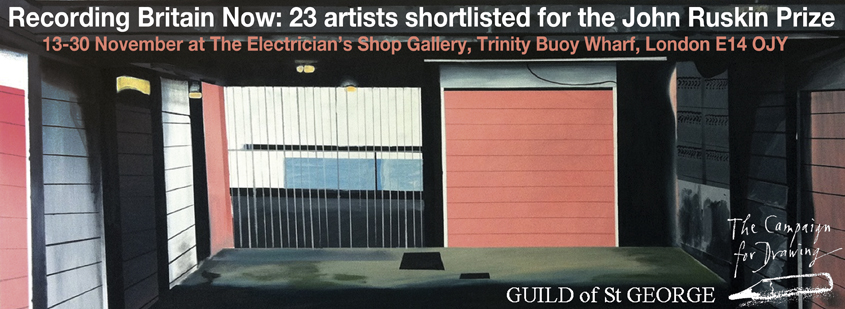
Sign up to our mailing list via the link on our homepage to receive details of entry for the 3rd John Ruskin Prize anoounced early January 2015.
For more on Mandy's work here: www.mandypayneart.co.uk
Recording Britain Now and associated programme is supported by the following partners:
